Avaya Stadium architect describes features of MLS's newest venue

SAN JOSE, Calif. – Creating North America’s largest outdoor bar at Avaya Stadium wasn’t the goal. It just worked out like that for architect Brad Schrock and the San Jose Earthquakes.
“How it became the largest bar in North America I don’t know,” Schrock, director of Sports + Recreation + Entertainment for HOK, told SI.com. “We didn’t set out to make it that, but the nature of the size of the opening and the desire to create this really active dynamic space it turned out to be that.”
With the bar playing a key role on the open end of the horseshoe at the brand-new stadium two miles from downtown San Jose and a Beers of the Worlds section at the south end, Schrock says the real focus of Avaya Stadium, though, centers around its European-style roof capturing the energy from the league’s steepest seating bowl.
MLS Power Rankings Week 2: NYCFC, Orlando climb; FC Dallas stays perfect
With a single seating bowl starting 10.5 feet above the field-level suites and party decks and at an angle of 30 degrees, no MLS stadium has a steeper rake, which means the last row of the 18,000-seat venue sits closer to the natural grass pitch than others of a similar size.
Fans will experience that Sunday night (7 p.m. ET, FoxSports1), when the Earthquakes host the Chicago Fire in the stadium's grand unveiling.
“We wanted a strong, but simple solution,” Schrock said.
Instead of placing the 16 suites mid-level and breaking up the bowl—and fan noise—he dropped the suites down low, off the concourse and pulled them toward the pitch, cranking up the rake of the bowl without going so high that fans would freak out near the top.
“All the sightline programs all of us designers use to design these seating bowls would tell you that you don’t need to be that steep,” he said. But forget the programs. “The steeper it gets the more people feel like they are on top of the action.”
Keeping the premium seating on the field allowed the Quakes to give close-to-the-action seating for premium payers and the general bowl.
Minnesota, Miami are on deck, but Sacramento ready for MLS expansion
But if the Quakes can fill Avaya Stadium with 18,000 raucous fans–the club announced this week that the maximum 12,000 season-ticket packages have been sold–Schrock wanted that to mean something from an energy standpoint. And while the stripped-down venue (his words) was an “exercise in putting the money where the fans and players benefited most” one place the ownership group did spend money on was the 90-foot canopy extending to the first row of seats.
“It is incredibly intimate and captures the energy of the fan,” Schrock said. “It harkens back to great European soccer venues, really tight, steep seating bowl with big overhangs to amplify the crowd noise.”
The roof connects to the back of the seating bowl so there’s no noise leakage and uses a metal deck and structural steel—the angularity of the steel on the sides of the stadium are to support the roof, even if a future façade will eventually put a covering on them—to capture fan energy and reflect acoustics back toward the pitch.
The canopy also helps from a fan comfort standpoint, providing shade for the folks not meandering the bar.
“It was an exercise in best value,” Schrock says. “Where do we put the dollars to get the most value out of it? The return on that is going to pay dividends in terms of fan experiences. It is one of those things that a lot of stadiums have not invested in in the past. It is not an inexpensive component, so you really have to believe it creates an incredible benefit to the fan experience.”
Critiquing every MLS uniform, head to toe
New York City FC

New York City FC took some heat for its sky blue home shirt, which looks a whole lot like the one worn by parent/sister club Manchester City. But an homage was inevitable, and NYCFC has differentiated itself from MCFC, and the rest of MLS, with the white shorts and socks. It’s a sharp look. The away kit, highlighted by a flash of orange (from the city flag) at the neck and five stripes you can barely see that "represent the five boroughs of New York City," is lazy. With a blank template, NYCFC should’ve come up with something other than the mono-black already worn in D.C. and Columbus.
LA Galaxy

After several overhauls—LA wore black and teal, then teal and yellow, then yellow and green—the Galaxy’s white and blue brand has taken root. Three championships in four years certainly help. The sash on the home uniform, re-introduced in 2012, has quickly become iconic, and, along with the socks, helps make this all-white kit stand out. The new secondary set maintains the same feel as its recent predecessors. The yellow accents look sharp, but we can’t help but feel a white or yellow sash would tie the uniforms and brand together.
Chicago Fire
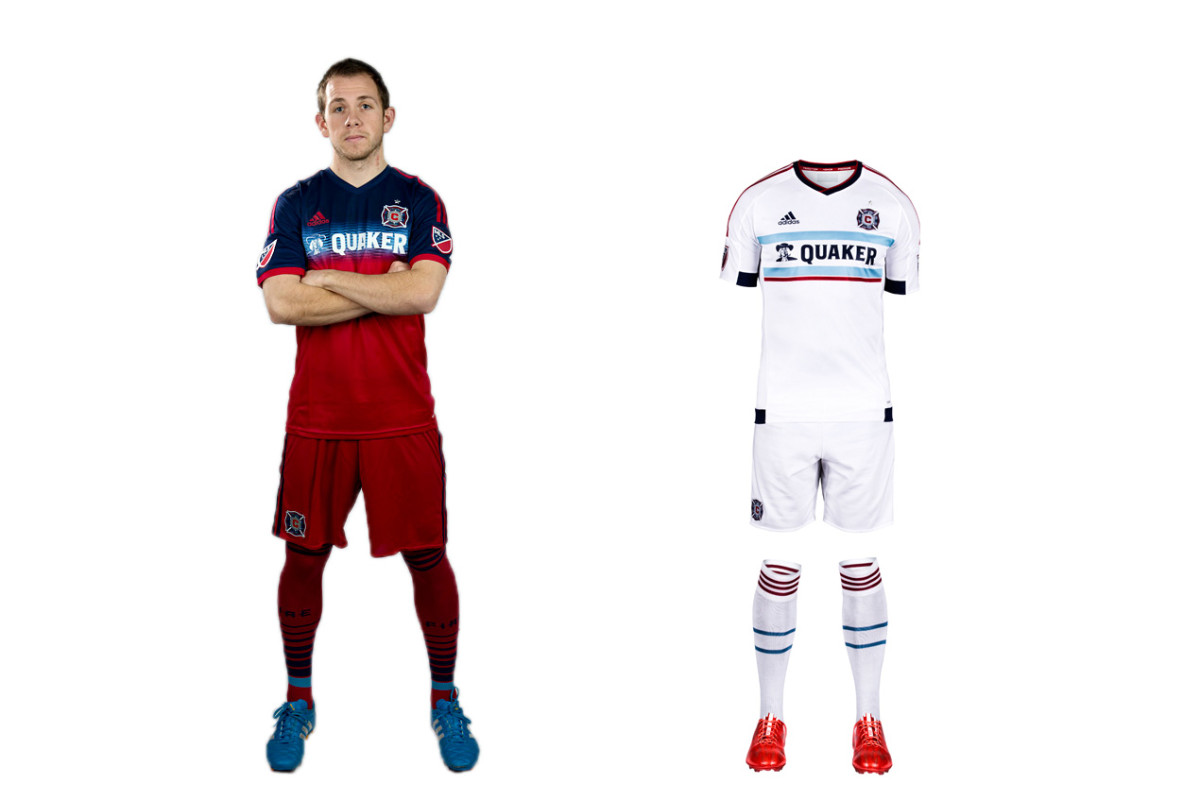
Of the four MLS teams with an all-red home uniform (that’s 20 percent of the league), the Fire were first. They’re the “Men in Red,” after all. But Chicago began veering away from its traditional look in 2012. First the famous white hoop became blue. Then last year, the blue expanded to the chest and shoulders. It doesn’t look bad, but it doesn’t seem right, either. The new away kit is another all-white offering. But at least designers put a bit of thought into this one. The thin, light blue hoops on the shirt and socks, intended to reflect the design of the city flag, are a nice touch.
Montreal Impact

Montreal exemplifies MLS/Adidas’ fixation on tiny details rather than the impact (sorry) a uniform makes when viewed from more than three feet away, which is where most people watch a game. The new away kit features a tiny silver fleur-de-lis affixed to the back and more woven subtly into the fabric. But overall, it’s just another anonymous all-white uniform that mirrors the existing, plain blue primary set. The tragedy is that Montreal’s gorgeous blue-and-black striped alternate, which would be the only striped kit in MLS, is gathering dust. It should be the club’s primary.
D.C. United

D.C. United calls itself the “Black and Red,” but its uniform palette typically has ignored the latter. That’s been rectified with the club’s new secondary kit, which features a welcome splash of red on the traditional white jersey. The home uniform, which carries over from 2014, still looks unfinished without the white chest stripes that were dropped in 2008. If D.C. could find a way to re-introduce them, perhaps above the sponsor logo and behind the crest, it once again would boast one of the sport’s most distinctive designs.
Real Salt Lake
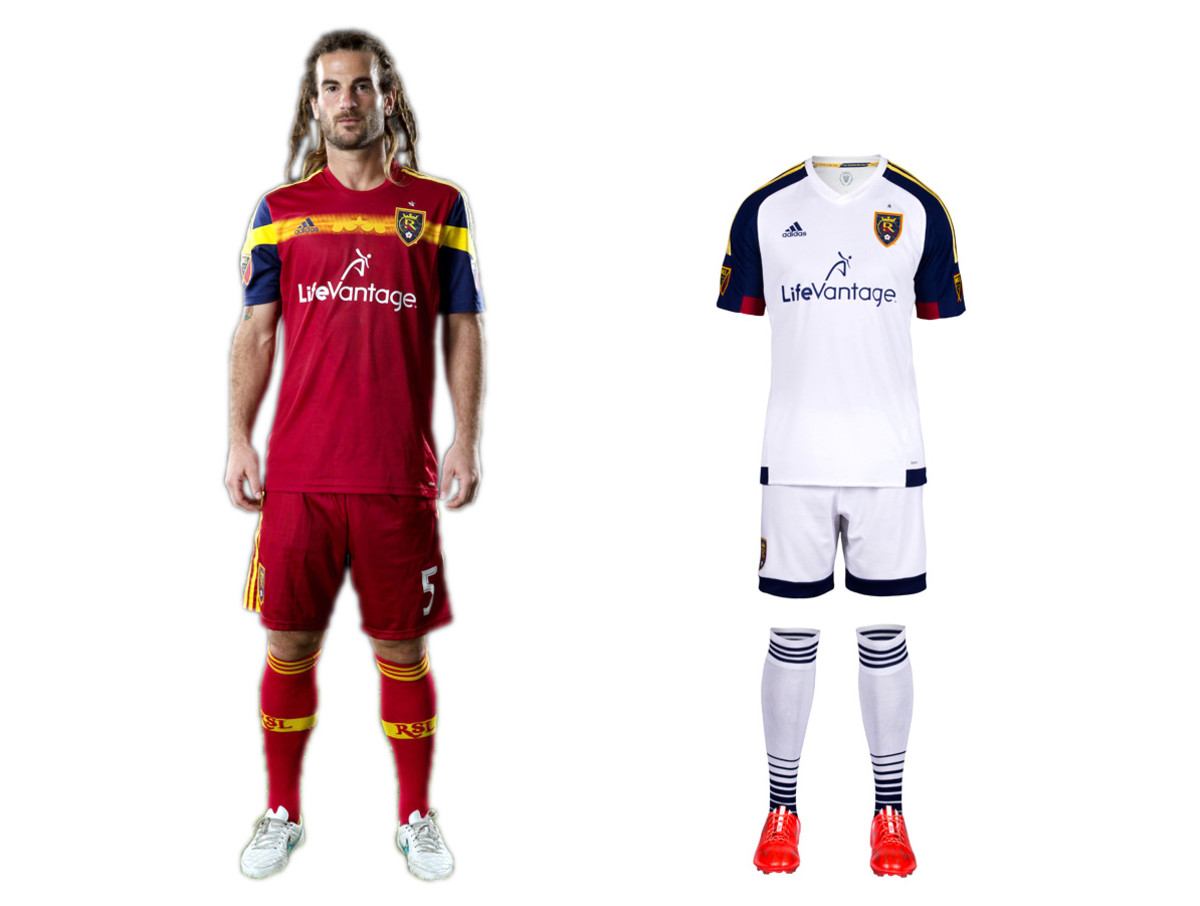
RSL stubbornly refuses to look great. It took a small step forward with its new secondary uniform, which now features two blue sleeves. It's too bad there isn’t even more of RSL’s beautiful claret, cobalt, and gold color scheme in the kit. The red home set carries over from 2014, making it six seasons since RSL abandoned the claret shirt, cobalt shorts/socks combo it wore when winning its only MLS title. The yellow chest stripe adds a little something extra, but RSL’s preference for an all-red kit similar to others around the league instead of a classy, one-of-a-kind look with championship pedigree is baffling.
Toronto FC
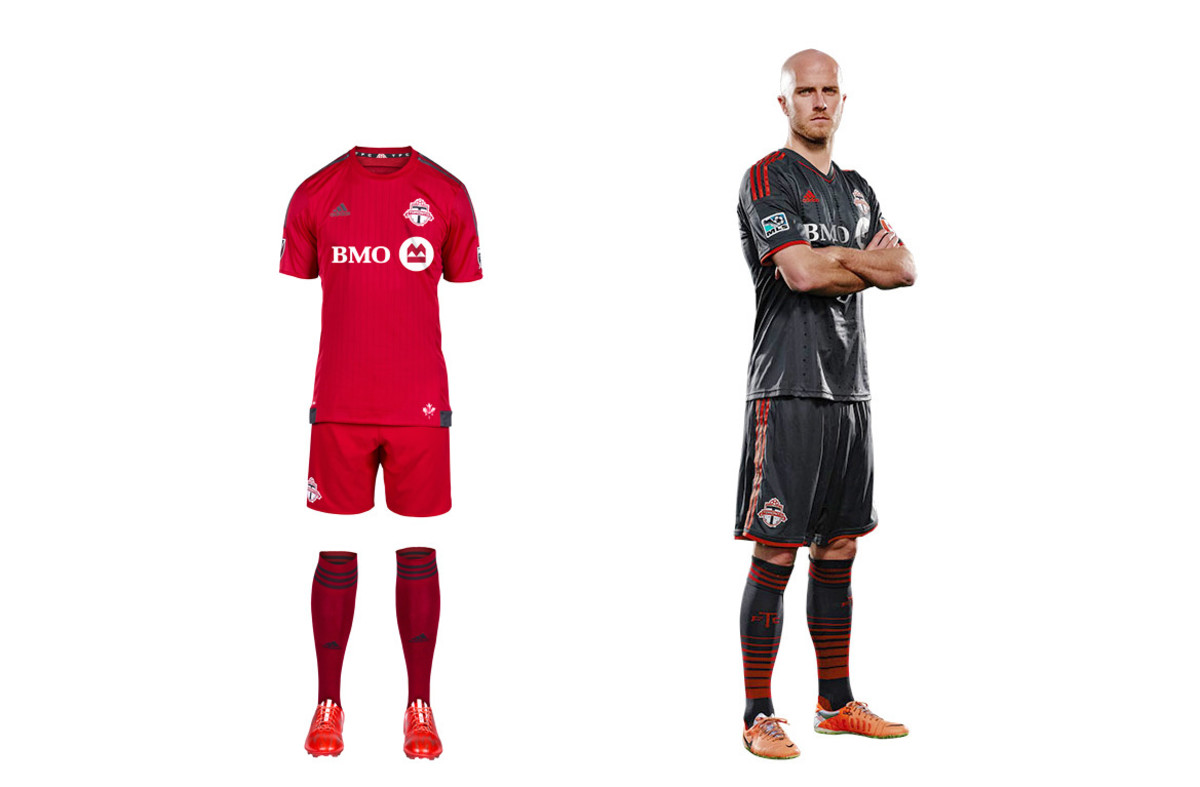
Toronto FC’s new home set could be the reddest uniform in the history of a league that loves red uniforms, which we suppose is noteworthy (guess Adidas insisted on the contrasting three stripes). Club management has focused on building a team capable of ending an eight-year playoff drought, likely leaving little time for kit design. The holdover secondary set is charcoal gray, which features in the TFC logo and is a unique uniform color in MLS. The hooped socks finish off a striking look and make us wish there was a bit more gray in the primary.
New England Revolution

The Revs are Exhibit A for the effect a second color, even if it comes from something as mundane as a plain pair of shorts, has on a club’s brand. Long a believer in boring, N.E. last year overhauled its home blues with white shorts and hooped socks. It’s a classy yet instantly recognizable look. The image shake-up continued Tuesday with a new secondary kit inspired by the regional flag flown during the American Revolution. The red-and-white set is clunky and geometric, but it’s different, daring and local. Better to take a chance than look dull and anonymous.
Philadelphia Union
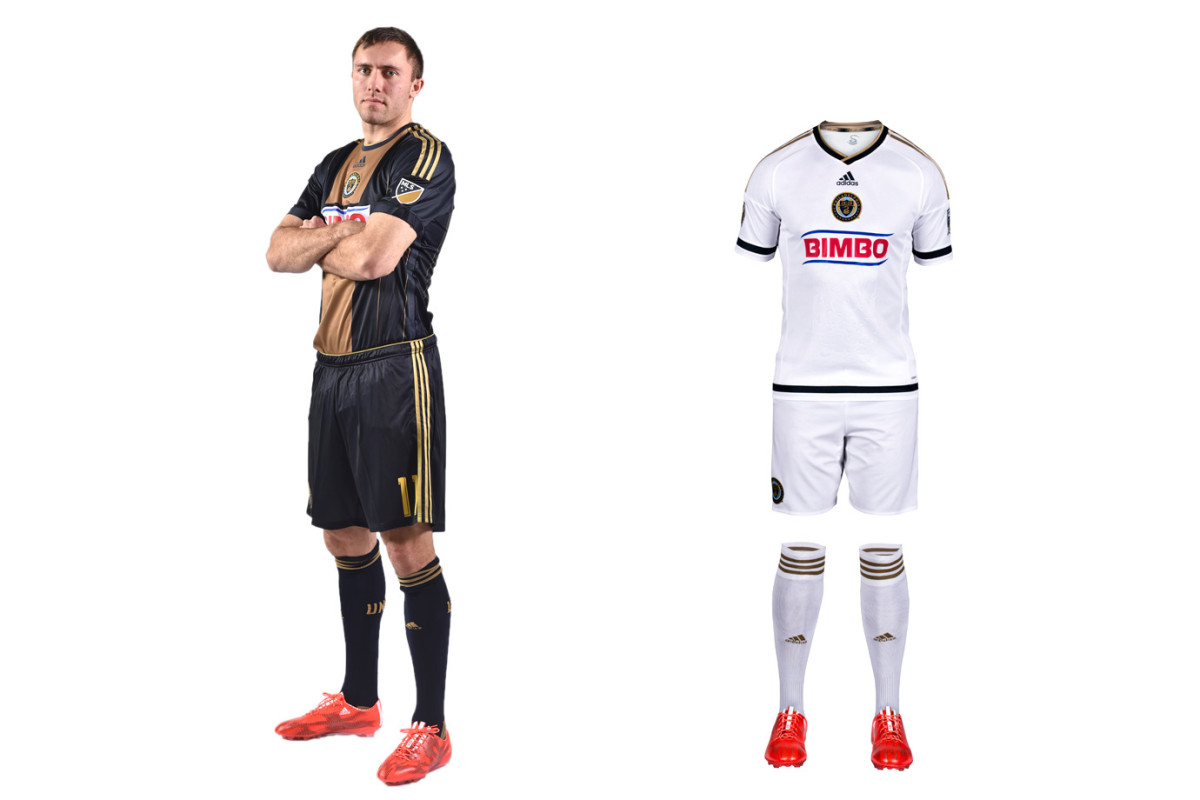
The Union got it right in 2010. The inaugural navy kit with the gold center stripe, reflecting the Philadelphia flag, was iconic. The gold-and-blue away set, a reversal of the primary, was one-of-a-kind. The holdover home uniform still looks great, although the sponsor’s logo wrecks the balance. But the new secondary is a disaster, a needless departure from the brand and an 10th all-white MLS kit. Once innovators, the Union are now followers. The “WE ARE ONE” collar slogan, the tiny snake below the neckline and the embossed stars on the front are lost in a sea of white.
Vancouver Whitecaps

The Vancouver Whitecaps new primary uniform is meant to be experienced up close. It’s slogan heavy. “Our All. Our Honour.” appears inside the neck and on the hip. “SINCE 1974” is on the back. The thin, diagonal pinstripes that featured on the previous home kit have been replaced by light blue shading designed to represent Vancouver’s water and mountains. It’s all a bit too subtle. The shirt will look nice with jeans, but in the end, Vancouver’s all-white kit—and the holdover mono-navy secondary—simply blends in.
Portland Timbers
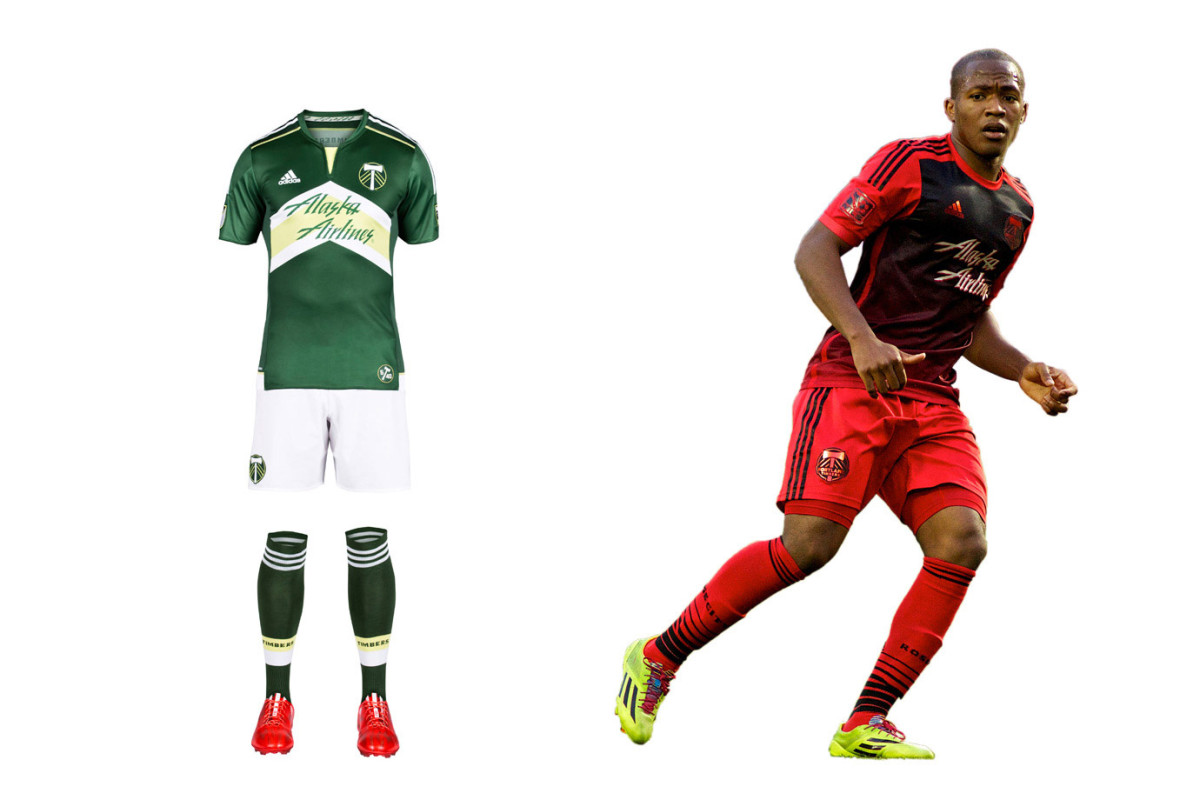
Portland quietly switched crests, from a logo featuring its name to a simpler version focusing on the axe and chevrons (the old logo lives on elsewhere). Few teams wear a badge with no writing, but the Timbers can because they’ve built such a powerful brand. Only they could wear the new home set, a bold green-and-white offering anchored by the chevrons. They're a bit wide, and the yellow below the collar clutters the shirt, but it's impressive overall. The road kit, released in 2014, is everything a good one should be: distinctive, perhaps edgy, yet connected to the club. In this case, Rose City red.
Columbus Crew
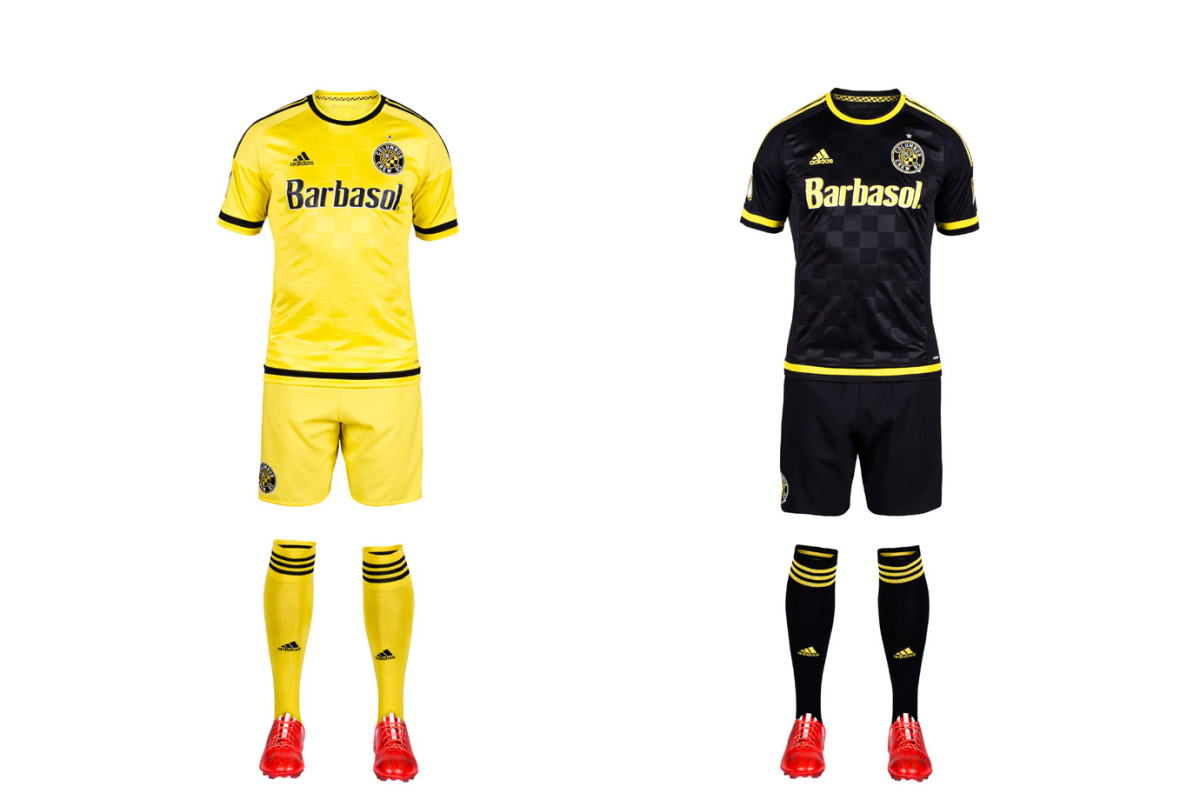
The Crew released new home and away sets featuring the club’s revamped logo, a roundel that looks nice enough but makes sense only with a cheat sheet. The explanations (the ‘O’ for Ohio, the founding year, the checkerboard pattern found in flags waived by fans) certainly tie the club to Columbus more than the goofy construction workers did. As the Crew forge ahead, they’ll stay true to their sartorial tradition. The all-yellow primary is simple but elegant, and certainly recognizable. The mono black secondary could use a bit of flourish–why so subtle with the checkers? But it works and shouldn't be needed that often, anyway.
Orlando City SC
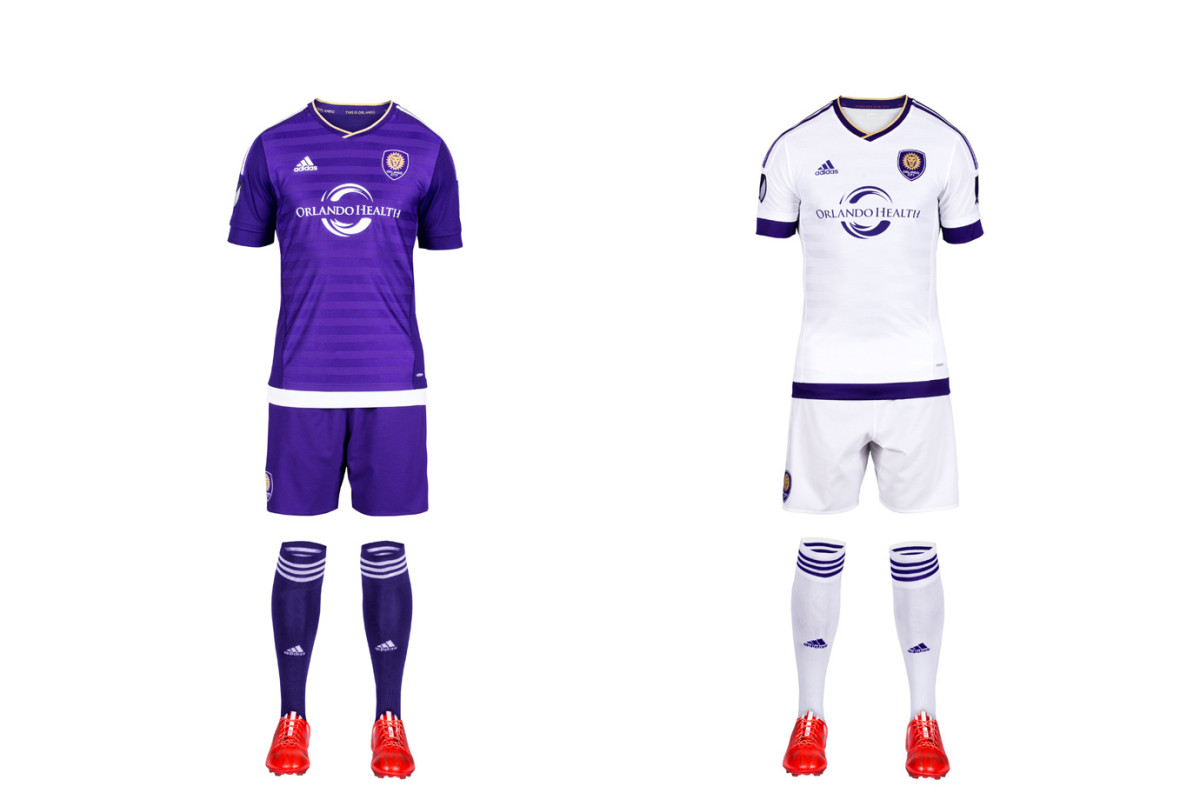
The Lions’ love for purple is welcome in a league featuring so many similar looks. But it didn't result in creative inaugural kits. The home uniform features more up-close details, like “jacquard engineered banding…representing Orlando City’s transition to a new era” and even the club's old USL logo inside. The mono-white secondary has colored hoops on the waist and sleeves and includes more small symbols and slogans. But it’s still just another white set. The answer is obvious—swap the socks. The “Chelsea” look is underrated. White hosiery at home and purple on the road would make all the difference.
New York Red Bulls
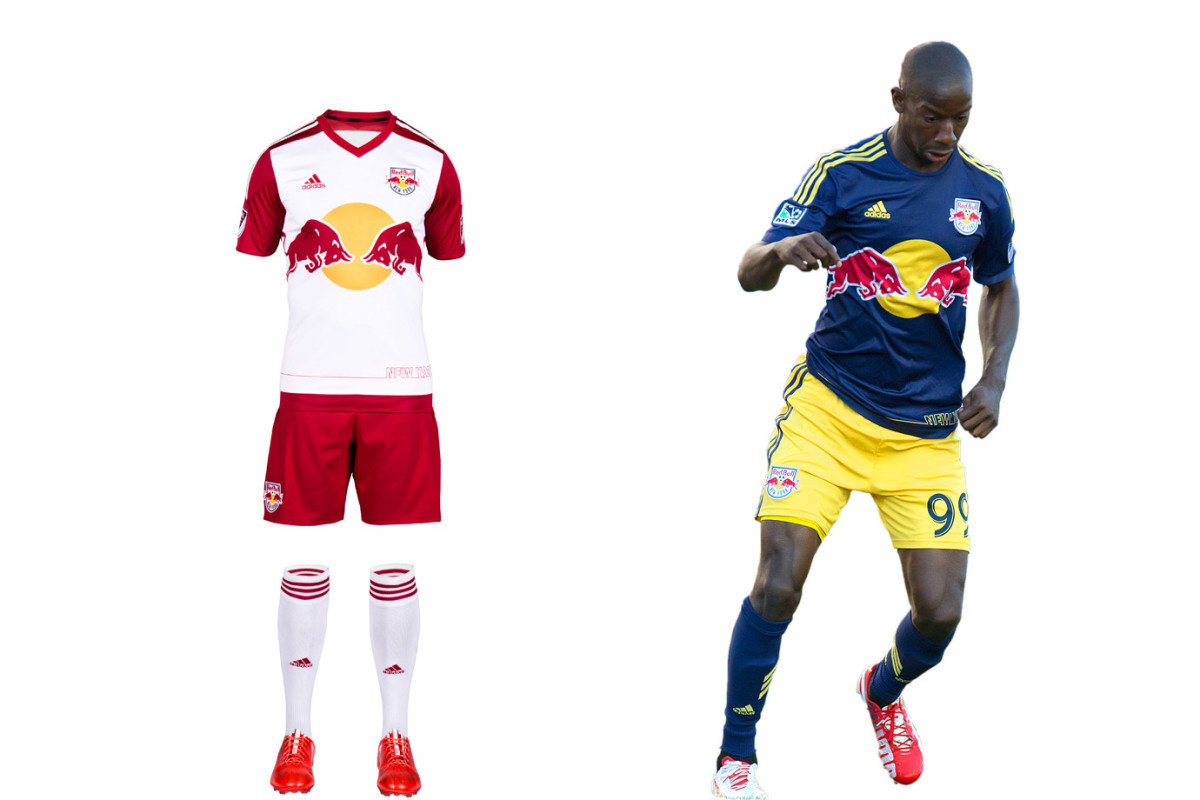
The Red Bulls have company in New York so have set out to reinforce their tenuous connection to the market within the constraints of the club’s corporate brand. The only white-red-white team in the league, RBNY now must compete with NYCFC’s pale blue. The Red Bulls’ new home set doubles down on that contrast with red sleeves and “NEW YORK” emblazoned on the shirt’s lower left in a manner “mimicking the iconic New York skyline.” The “EST.1996” on the back collar reminds fans who was there (or nearby) first. The holdover secondary definitely is unique and is great in reasonable doses.
Houston Dynamo

Houston’s club motto is “Forever Orange,” and while that remains the cornerstone of the brand, the Dynamo typically add a wrinkle here and there to ensure we’re not beaten over the head with it. The new home uniform is a great example. The white shorts and checkered fade on the jersey add the right amount of contrast. On occasion, the Dynamo have worn monochrome both home and away. But there’s no need to do so, especially on the road. The balance in the primary kit and the immediately identifiable orange shorts with the secondary set showcase the Dynamo at their best.
Sporting Kansas City

From irrelevant to trendsetting, SKC has profited from one of the most successful sports rebrands in recent history. The club now must share light blue with NYCFC, but Sporting still stands out. The new home set is a departure form the bicolor “state line” uniform of 2013-14 and is anchored by a “fashion-forward window pane pattern” that’s almost as preppy as the recent argyle alternate kit. The secondary uniform is stunning. The hoops, which mirror the stripes on the club crest, highlight one of the most eye-catching sets in MLS history. It’ll be tough to see it go after this season.
FC Dallas

FCD’s kits are an example of a good idea, poorly executed. The club made an inspired decision to go with hoops when rebranding in 2005, but the jerseys always let them down. Unnecessary seams, plackets and panels always ruined the shirt. Dallas gave up last year and went with a boring all-red primary. But it stuck with the hoops on the new blue-and-white secondary, where the side panels and sleeves still disrupt the flow. Both blue and white shorts are an option. Our 2016 ideal: a primary jersey with seamless, sleek red and blue hoops. Unique and colorful, but less jarring. Make it happen.
Colorado Rapids
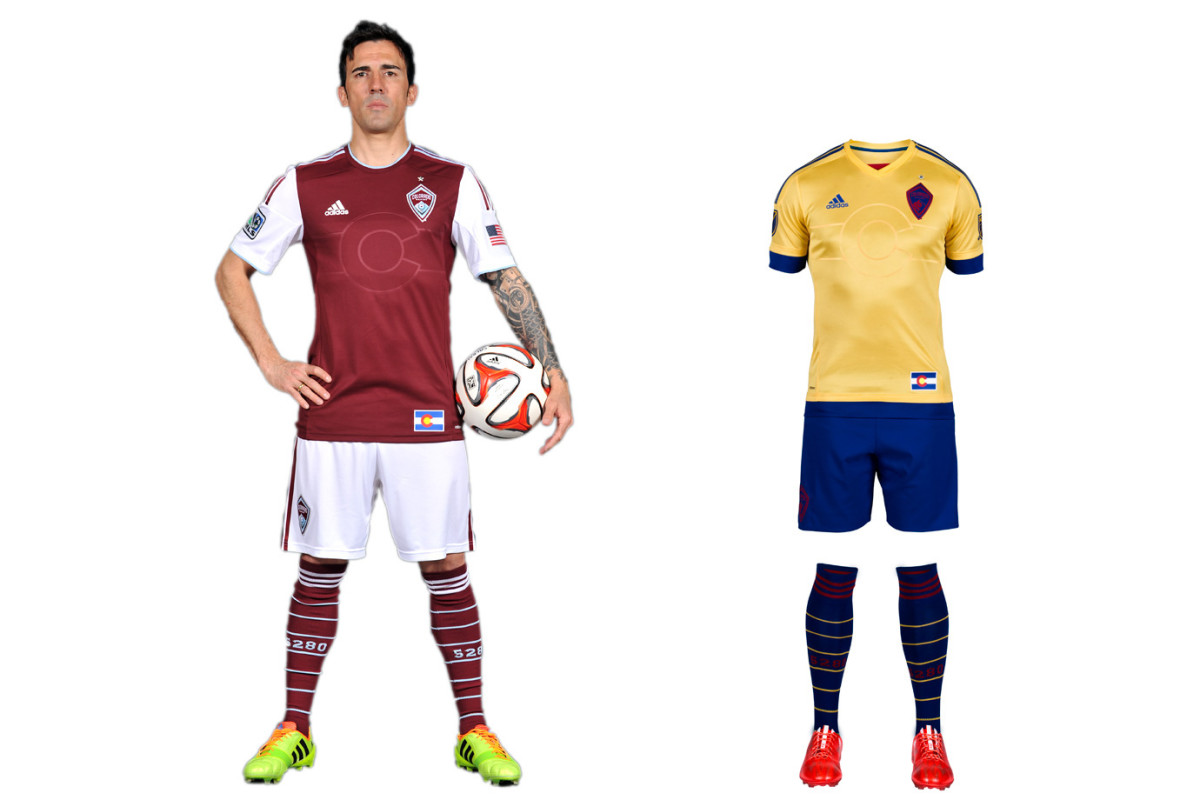
Another club that’s bounced from brand to brand (green-and-white, blue-and-black), the Rapids have settled in nicely with the unique but elegant burgundy-shirt, white-shorts combo. The sleeves, which mirror those worn by sister club Arsenal, add a subtle touch of flair. The new away uniform is a prime example of how a secondary kit can be tasteful and connect to a club’s brand. Last season’s mono blue state-flag set has evolved into a sharp gold-and-blue kit that maintains Colorado's colors and stands out from the crowd. We’re not fans of recolored badges—logos should be sacrosanct—but overall it’s a winner.
Seattle Sounders

The club that brought us rave green, cascade shale, super cyan and electricity has succumbed to the all-white virus. Seattle is one of five MLS clubs to adopt the look this season, ensuring half the league now embraces the white-out copout. The Sounders new away kit is especially devoid of any personality—a surprising choice for a club that has much of it. The new home set features a less cluttered shirt than in seasons past. It’s a template, but it’s a step up. The uniform also features blue shorts and socks for the first time. Here’s hoping we see it as often as possible.
San Jose Earthquakes
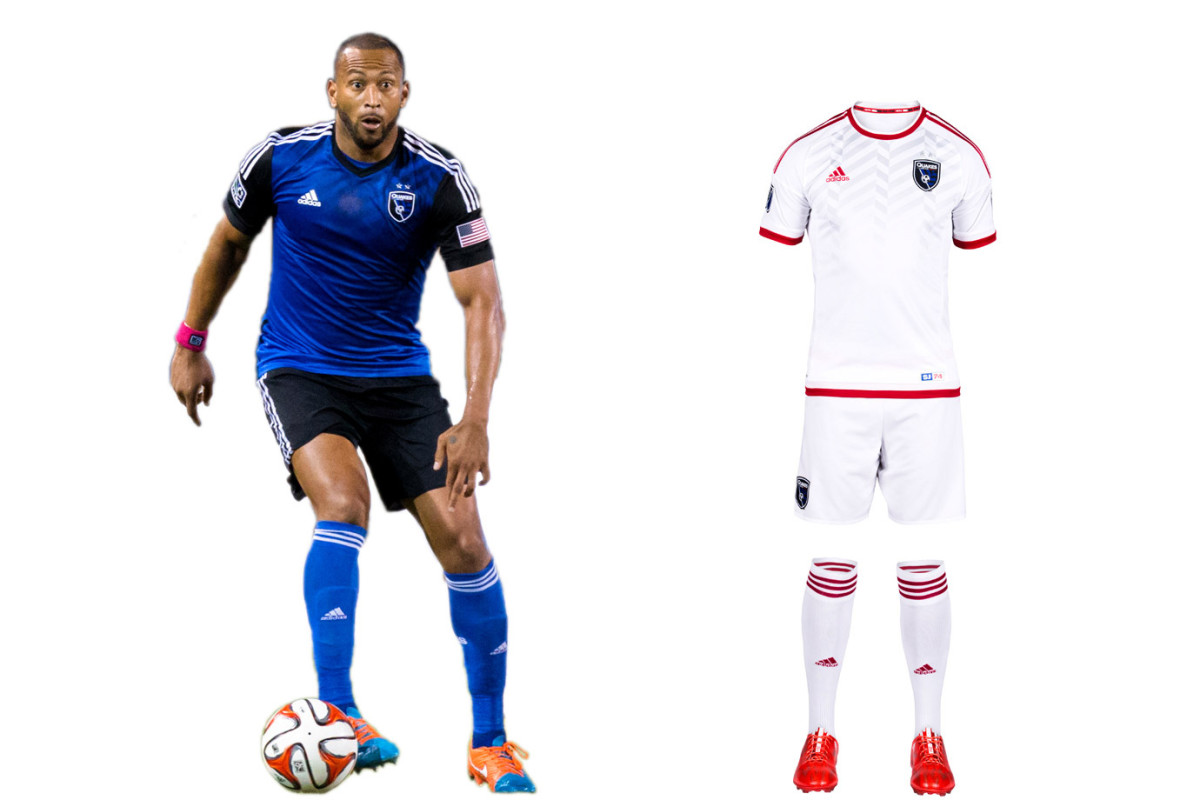
"Earthquakes" is an appropriate moniker for a club that’s experienced so much upheaval. While the new Avaya Stadium offers stability, the brand remains in flux. SJ’s '14 overhaul produced a beautiful blue-and-black primary kit that’s already a modern classic. But the logo, awkwardly anchored by “Quakes”—a nickname of a nickname—lacks gravitas. We liked the re-introduction of the NASL-era red, which inspired last year’s away kit. That’s been replaced by a new white secondary set (yes, another one). It lacks the creativity, individuality and ambition that should be associated with a Bay Area club on the rise.
Designers kept the roof as flat as possible to capture more noise, but the roofing material pulls back at the end to ensure the entire pitch gets the sun it needs to grow.
The ends, though, that is where Avaya Stadium offers up some beer-centric culture. The south bowl has a tiered standing area for supporters near the Beers of the World concession. The first standing platform sits at field level and steps up from there.
The story behind the bar on the north end didn’t start with a bar.
“The only negative with a horseshoe is without something in that end, the experience tends to bleed,” Schrock said. “We proposed an LED board and a bar that stretched across from stand to stand to not only help enclose that end, but create this dynamic space that would become a focal point. It is funny, it immediately got some traction.”
The 3,647-square-foot bar was designed 55 feet behind the north goal under open slots in the underside of the scoreboard so from the view from Coleman Avenue on the outside it looked transparent, but coupled with the board and “Epicenter” fan space, there was “massing” in the north end that helped complete the Avaya Stadium experience.
Even if it took North America’s largest outdoor bar to make it happen.
Tim Newcomb covers stadiums, design and gear for Sports Illustrated. Follow him on Twitter at @tdnewcomb.
GALLERY: Soccer at baseball stadiums
Soccer at Baseball Stadiums
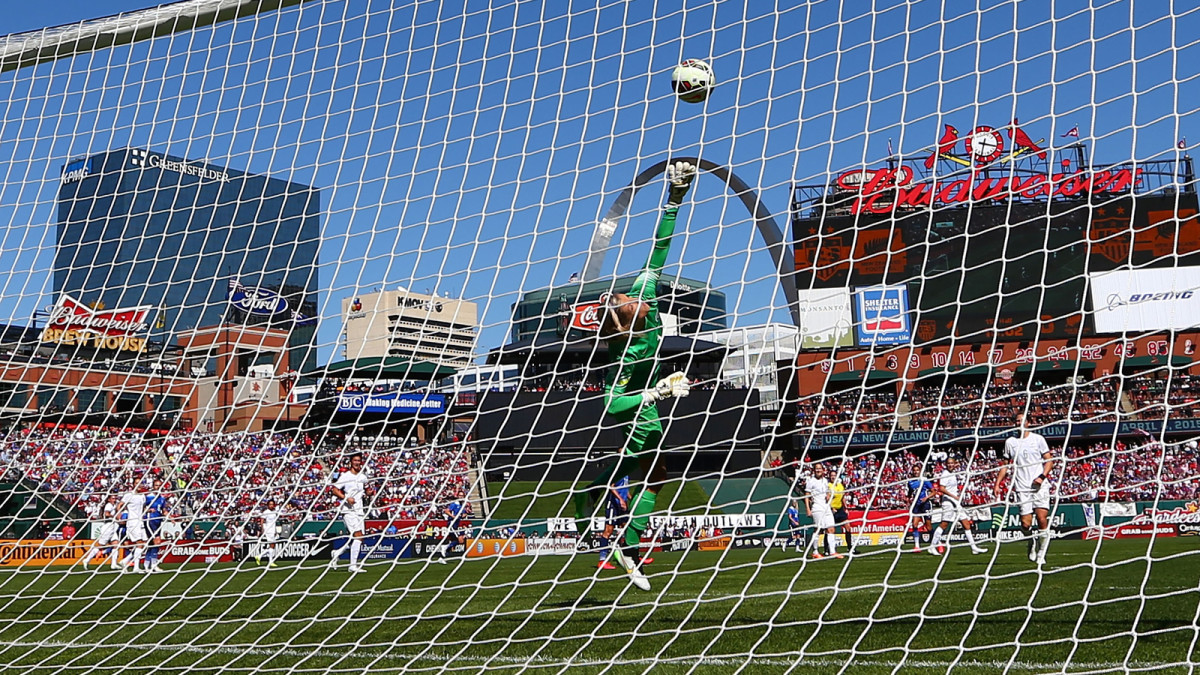
The U.S. women's national team played New Zealand in a pre-World Cup friendly at St. Louis's Busch Stadium on April 4, 2015.

New York City FC kicked off its Yankee Stadium era Sunday evening with a 2-0 victory over the New England Revolution. The MLS expansion club will play at the famed baseball venue for the foreseeable future, as it continues its quest to land a soccer-specific stadium in the Big Apple. But it’s not the first team to play soccer in Yankee Stadium–new or old–and it’s just the latest instance of soccer being played on Major League Baseball fields. Here are some instances throughout the years.

New York City FC takes on the New England Revolution during the club's inaugural game at Yankee Stadium on March 15, 2015.
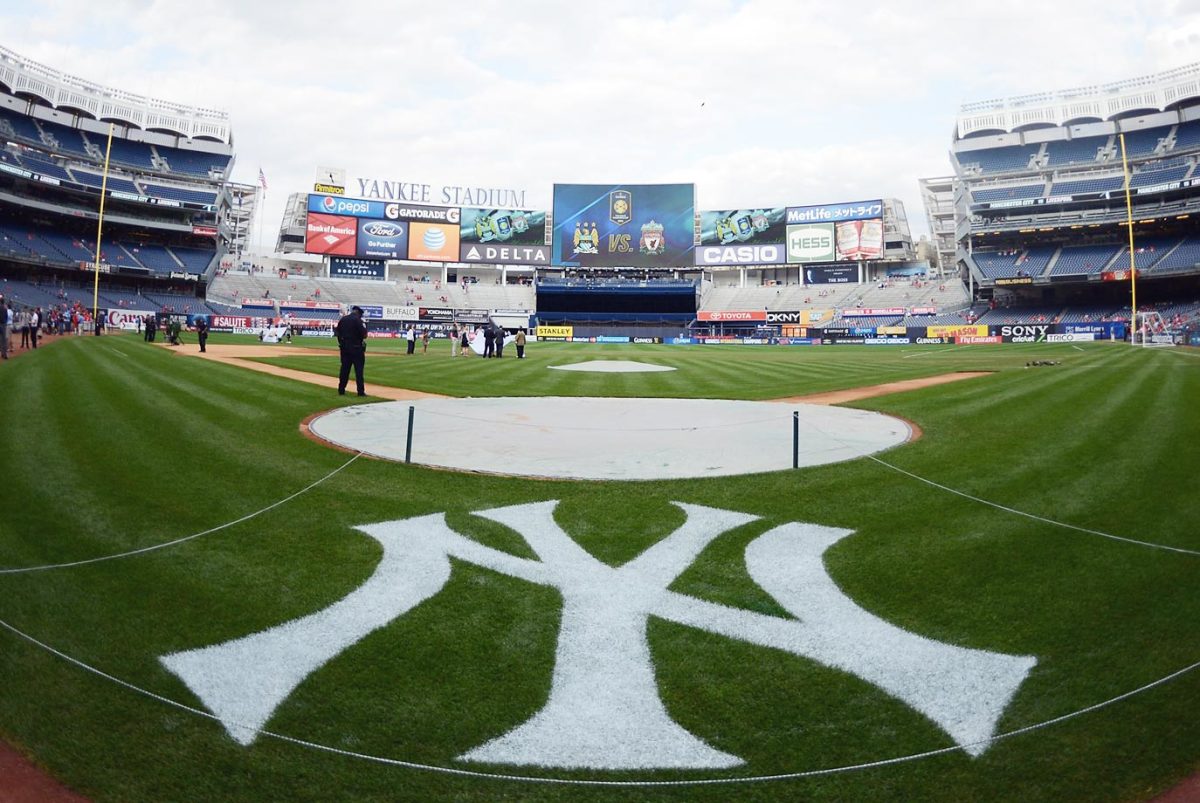
Yankee Stadium set up for soccer on July 30, 2014.

Before the club's rebrand to Sporting Kansas City, the Kansas City Wizards played the 2008-2010 seasons at CommunityAmerica Ballpark, the everyday home of the minor league Kansas City T-Bones.
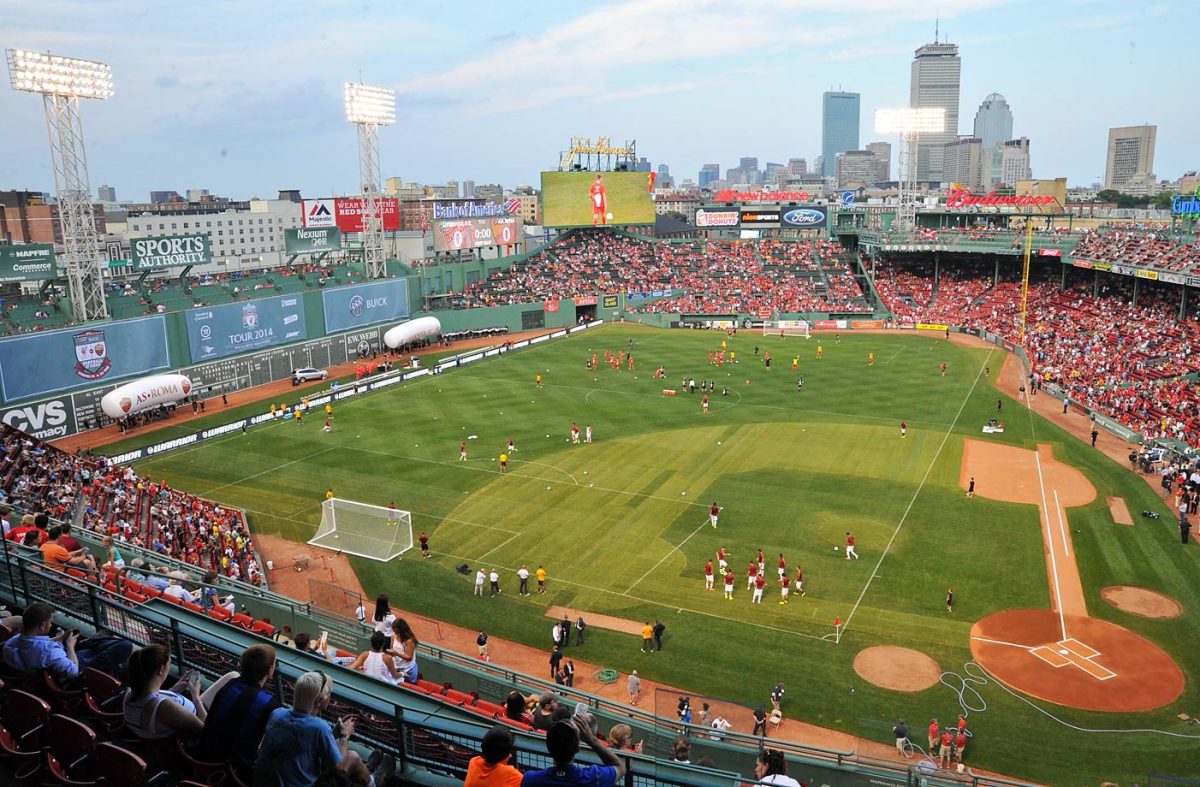
Liverpool played AS Roma at Fenway on July 23, 2014.

Liverpool played AS Roma at Fenway on July 23, 2014.
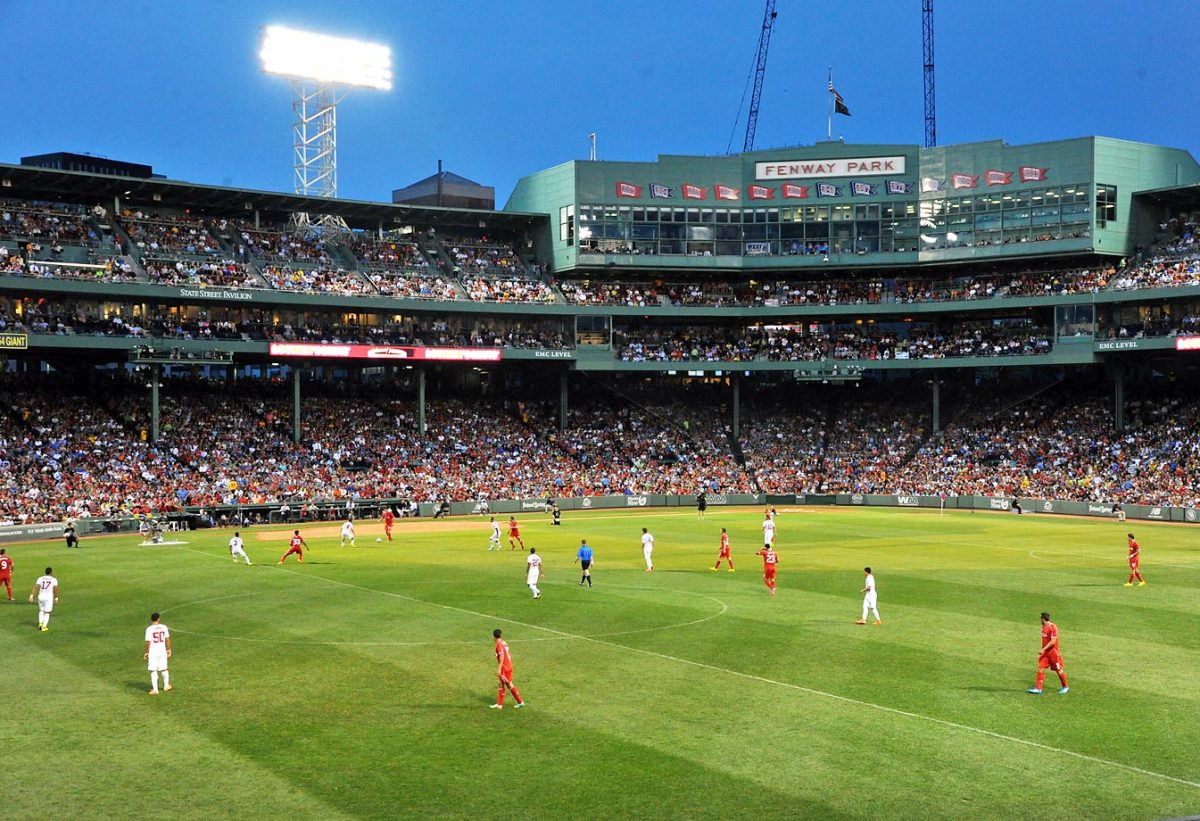
Liverpool played AS Roma at Fenway on July 23, 2014.
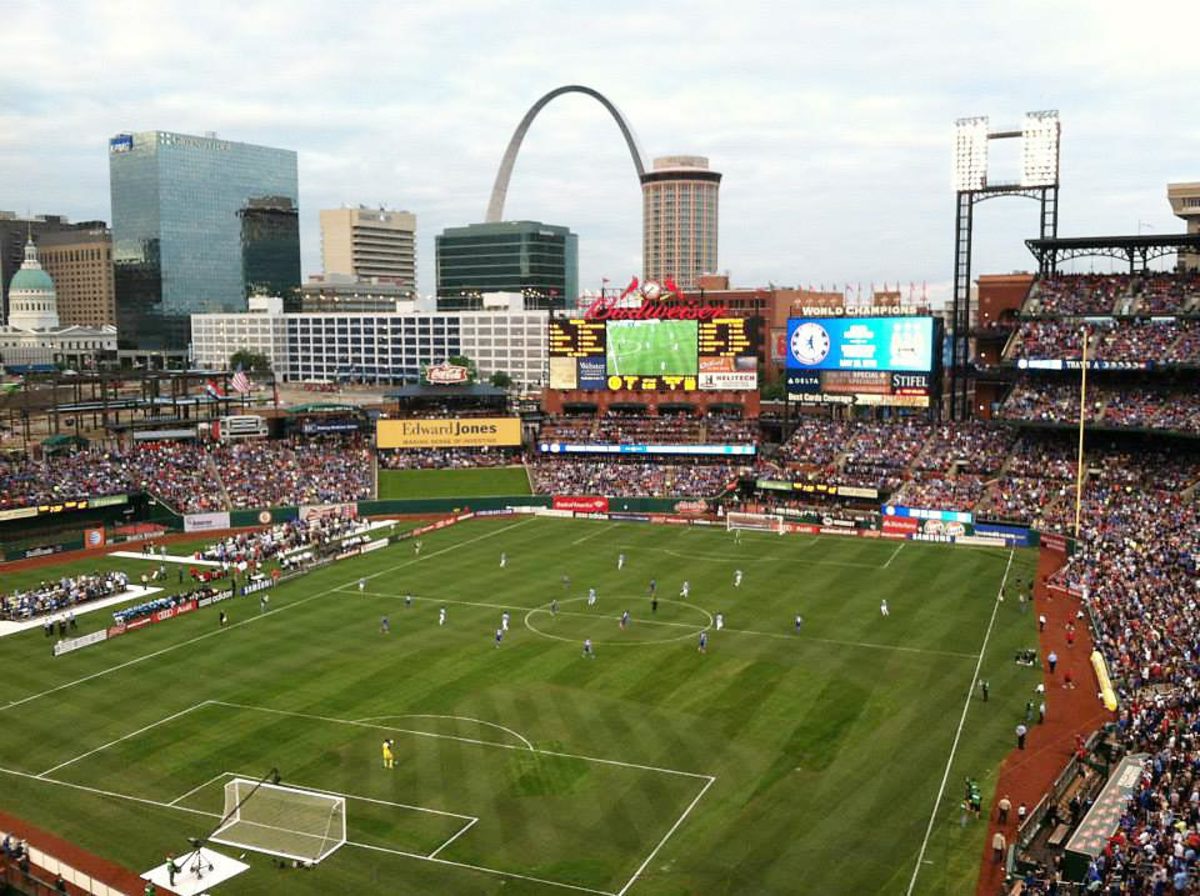
A Chelsea-Manchester City friendly match in 2013 at Busch Stadium.
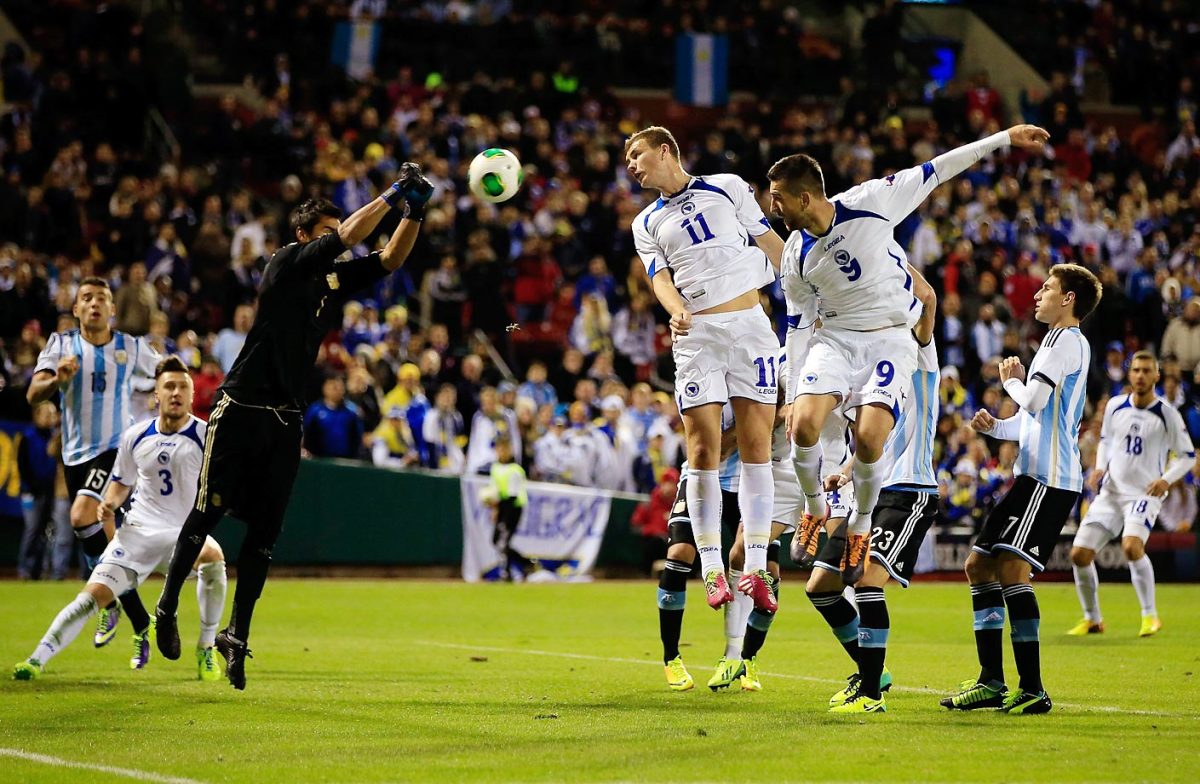
Argentina played Bosnia-Herzegovina during the international friendly match at Busch Stadium on November 18, 2013.
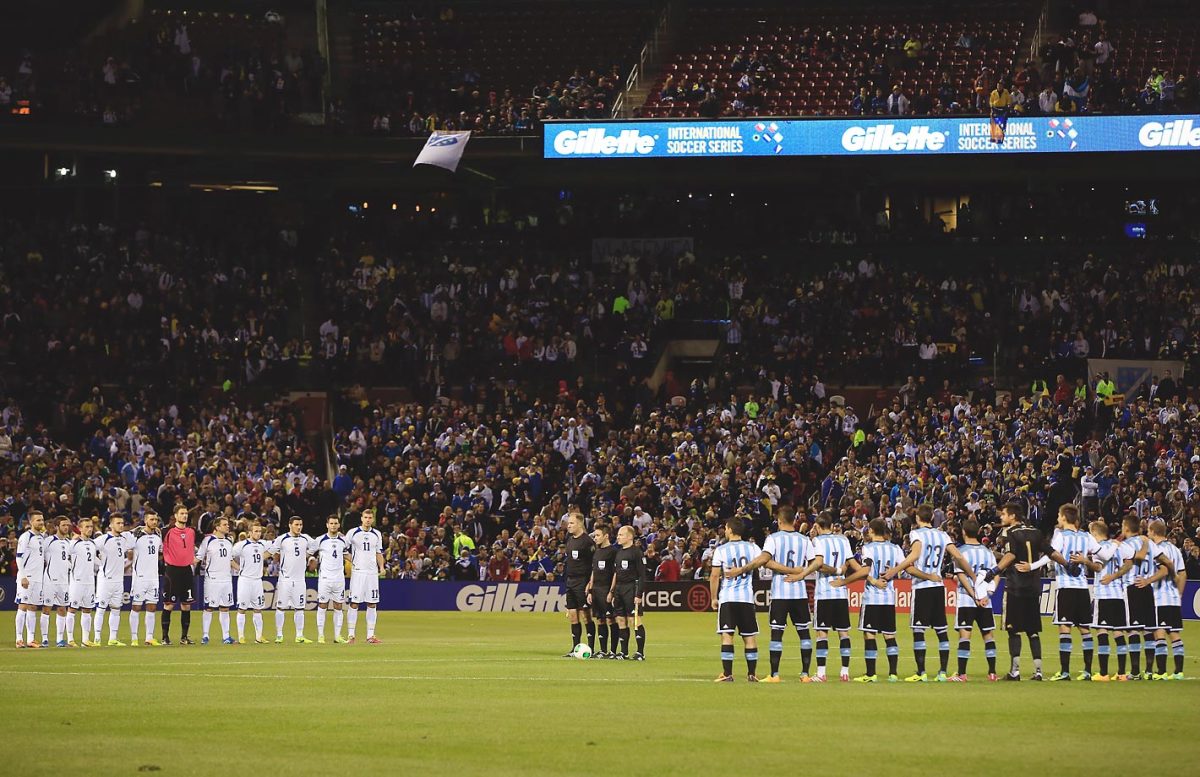
Argentina played Bosnia-Herzegovina during the international friendly match at Busch Stadium on November 18, 2013.

Brazil played Chile at Rogers Centre in Toronto on Nov. 19, 2013.
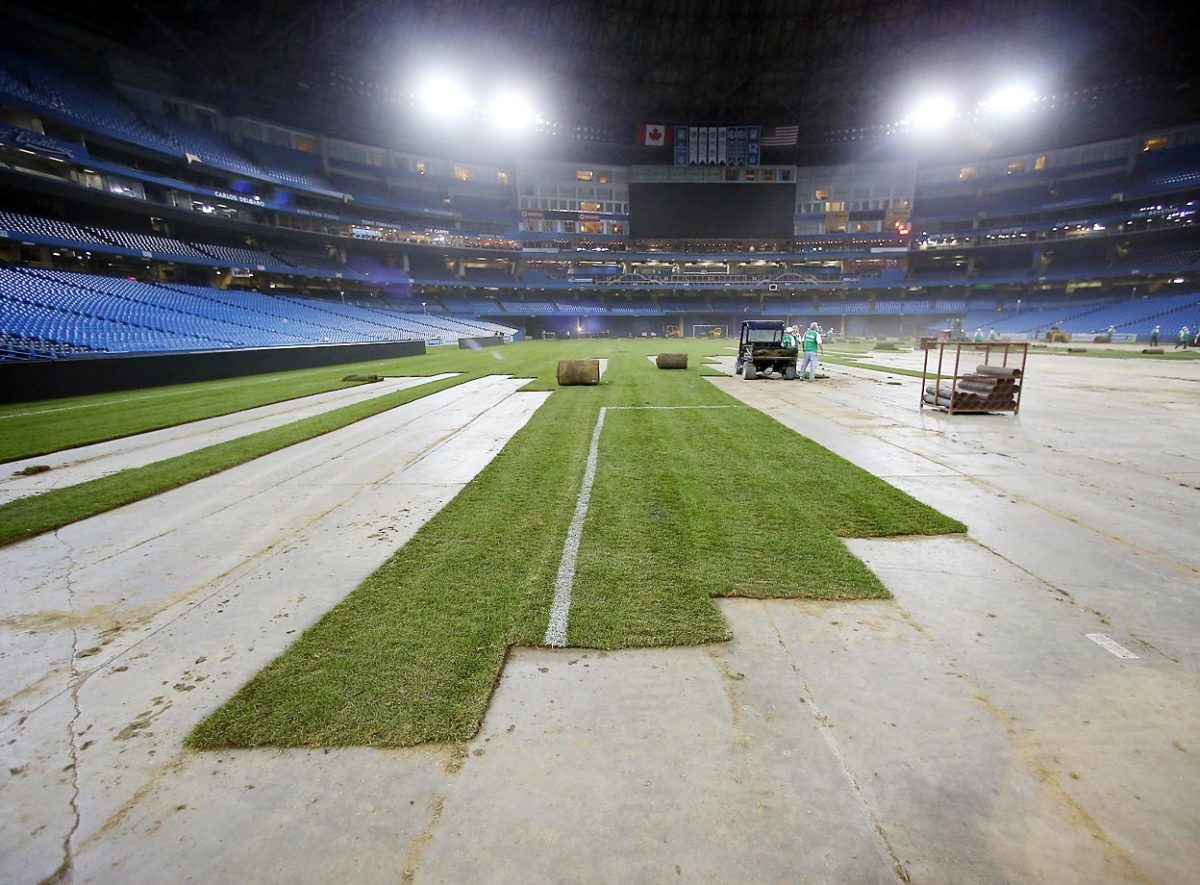
Brazil played Chile at Rogers Centre in Toronto on Nov. 19, 2013.
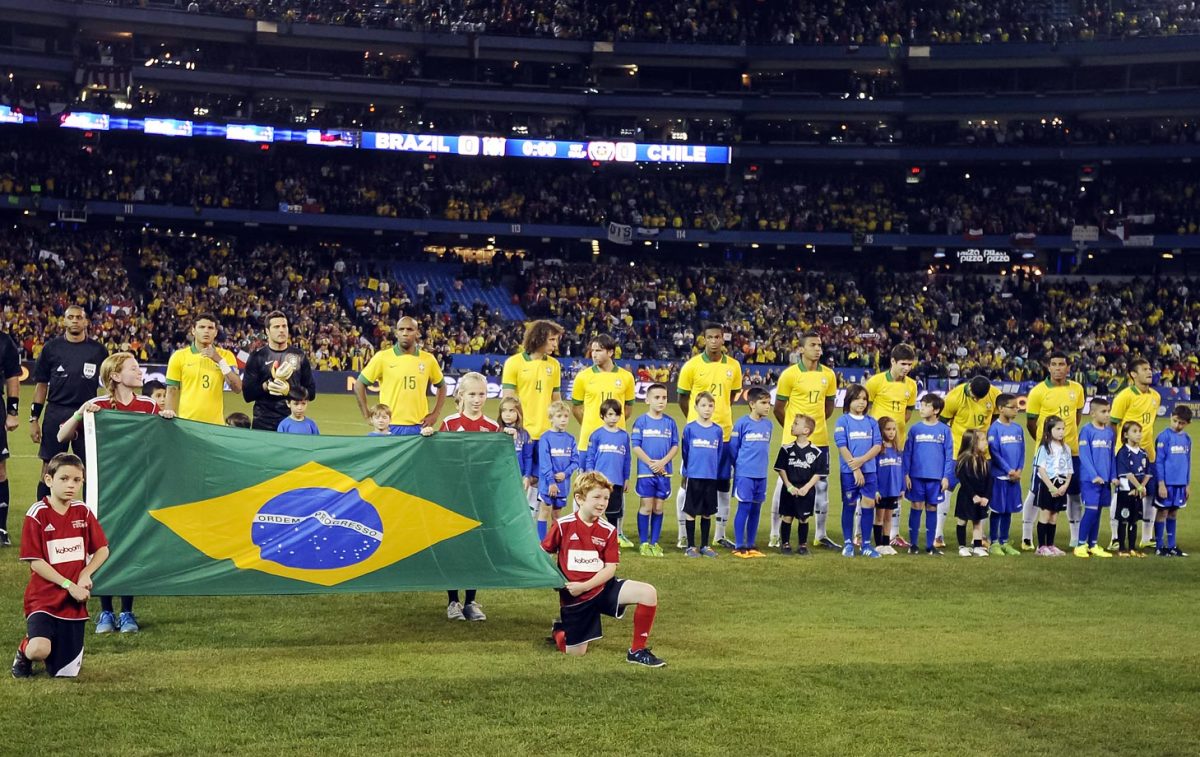
The Brazil team on the field before playing Chile at Rogers Centre in Toronto on Nov. 19, 2013.
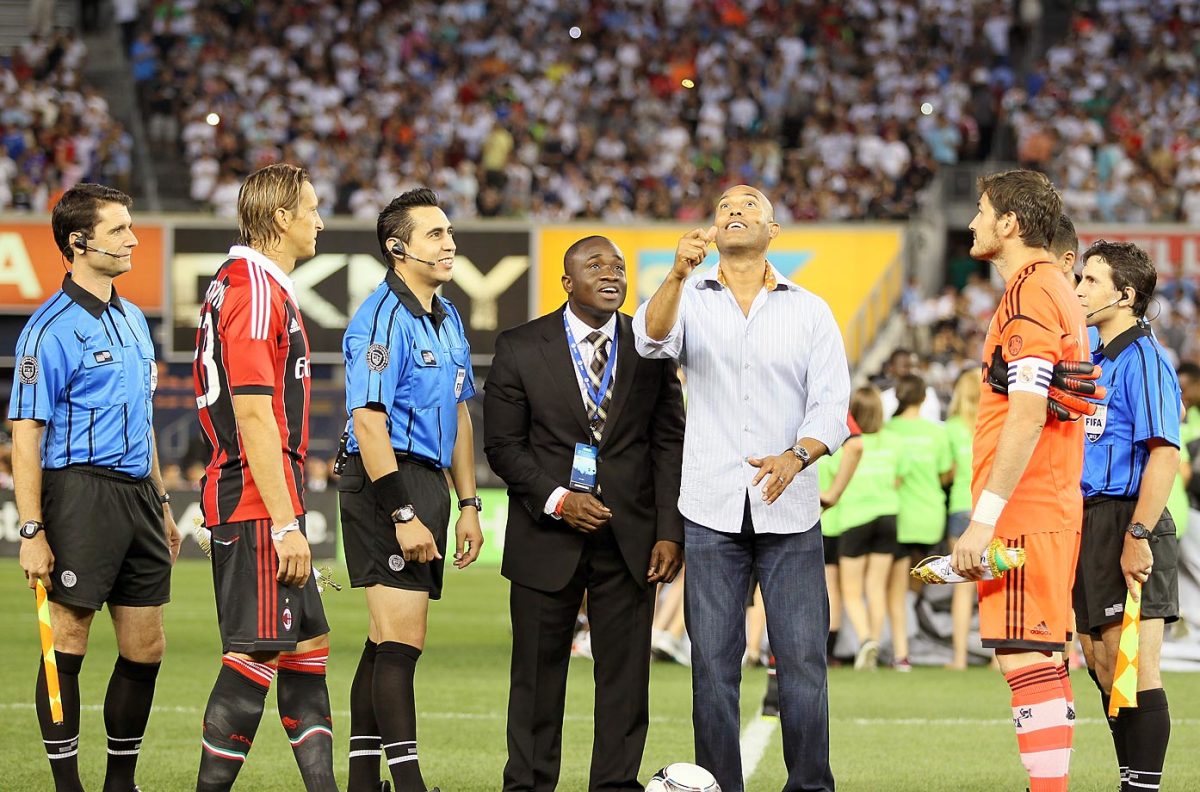
Mariano Rivera of the New York Yankees tosses the coin before the International Friendly match between Real Madrid and AC Milan at Yankee Stadium on Aug. 8, 2012.

Real Madrid played AC Milan at Yankee Stadium on Aug. 8, 2012.
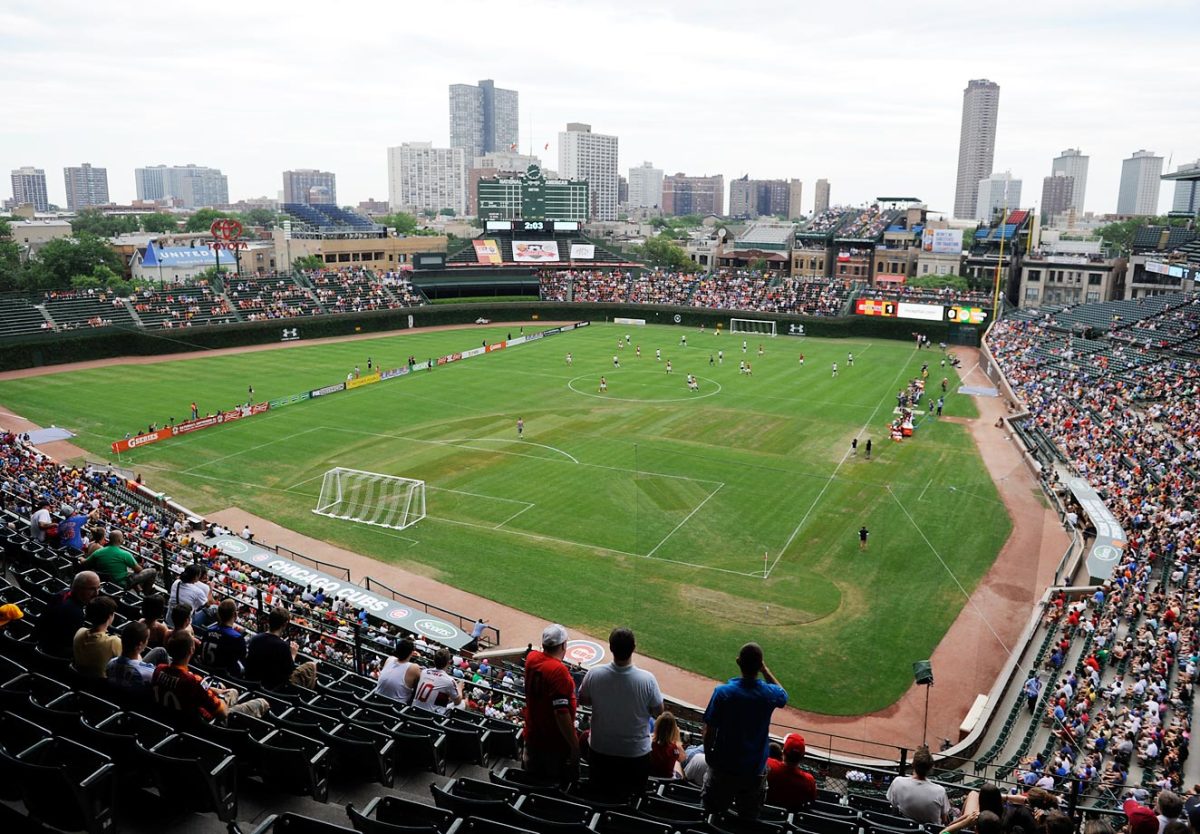
A.C. Roma played Zaglebie Lubin at Wrigley Field on July 22, 1012.

A.C. Roma played Zaglebie Lubin at Wrigley Field on July 22, 1012.
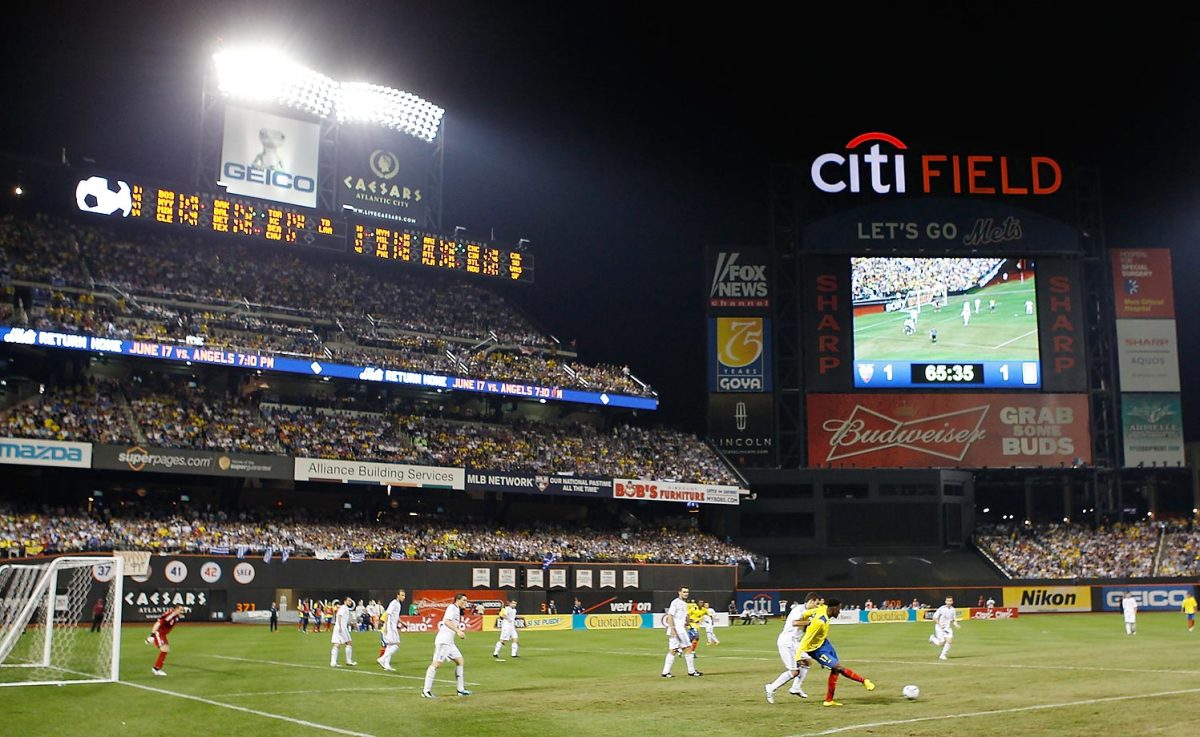
Ecuador played Greece at Citi Field on June 7, 2011.

Juventus FC played Club America at Citi Field on July 26, 2011.

Mike Cameron of the Boston Red Sox on the field at Fenway before the start of a game against the Los Angeles Dodgers on June 20, 2010. An image of a soccer ball was mowed into the center field grass to promote a match between Scottish club Celtic FC and Portuguese club Sporting CP that is set to take place at Fenway Park on July 21st.
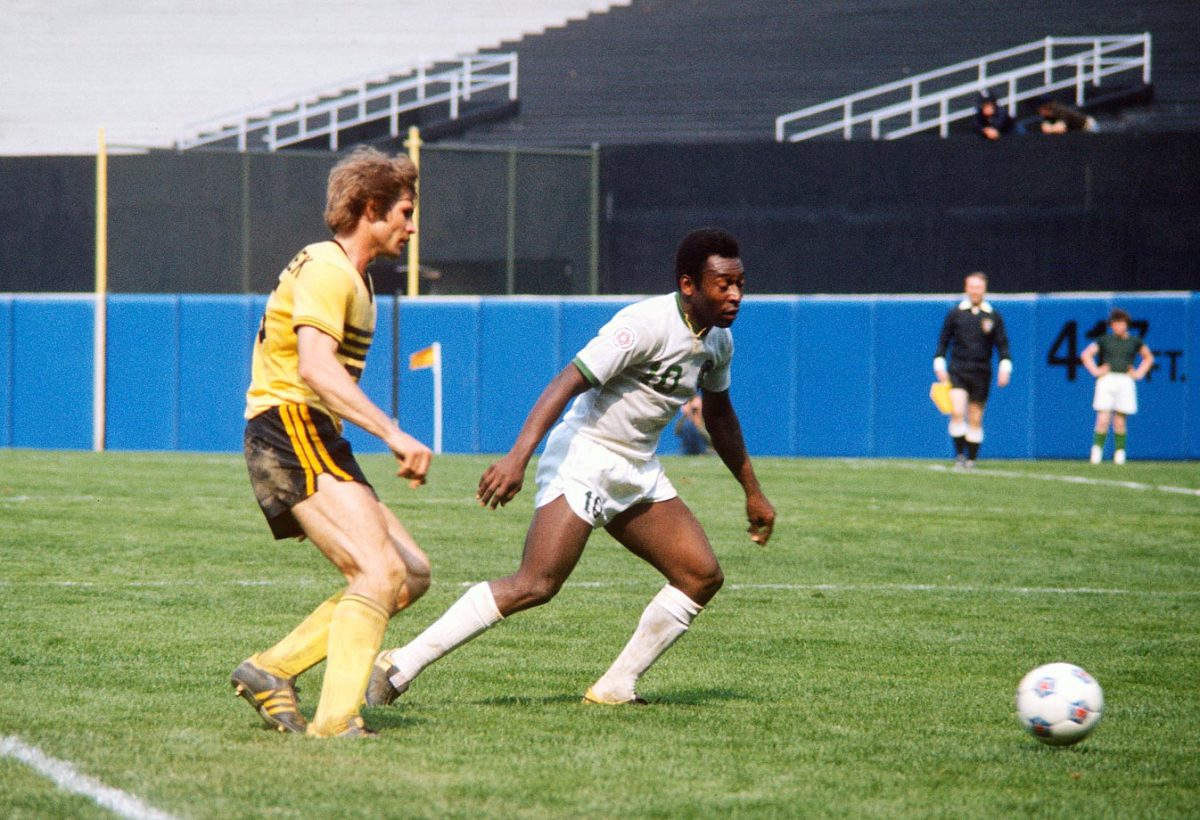
Pele, while playing with the Cosmos in the 1970's, played in Yankee Stadium.

Pele played for the Cosmos from 1975-77.
